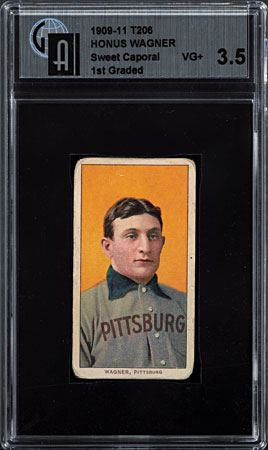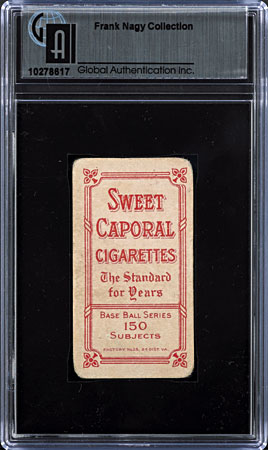The Frank Nagy T206 Honus Wagner GAI 3.5 sold for $456,057
Written by T206museum (December, 2005)
MastroNet Inc. sold
the Frank Nagy T206 Honus Wagner GAI 3.5 for $456,057 in their
December 2005 auction.


The following is the auction description:
"My Mentor Frank Nagy" by Bill Mastro
Frank Nagy was raised in a tough inner-city neighborhood of Detroit. As a youngster, he snuck
into Briggs Stadium to watch his beloved Tigers feast on American League pitching. His heroes
were blue-collar gritty guys like Hank Greenberg, George Kell, Walt Dropo, and Vic Wertz. Like
all the other kids, Nagy collected baseball cards; but unlike most of us, he never had the
earth-shattering experience of his mom throwing them all away. He just kept accumulating more
and more cards.
In the early 1950's, by the time he realized there was actually a bona-fide hobby, Nagy
already had tens of thousands of cards going back to the 1930's. He never did anything small.
He was a big man whose appetite for tiny pieces of cardboard was insatiable. In 1959, Nagy
brokered one of the greatest deals in the history of our hobby, spending the entire life
savings of his family to purchase the humongous collection of Walter Corson. Old Walt was
terminally ill. The entire upstairs of his house was filled with all kind of cards, including
those most coveted by Nagy baseball cards! Corson had run a few ads in the archaic (by today's
standards) trade papers of the hobby with an asking price of $10,000 for his entire assembly.
Ten grand was a king's ransom back in 1959, and after a few months of ads there were still no
takers. Nagy called Corson, then jumped in the old woody wagon and headed out to Pennsylvania
in the hopes of making a deal face to face. Three days and $6,000 later, Nagy had charmed the
aging Corson into accepting his offer. He stuffed the car to capacity and shipped dozens of
cases to his home in Detroit. (Keep in mind that the collection went back all the way to the
1880's and everything, of course, was made prior to 1959. Hard to believe, but there were 18
complete sets of 1952 Topps, all in uncirculated condition. Nagy liked to tell the story
about how he had to beg people to buy the sets for $80.00 apiece.)
With Corson's amassment added to his own vast holdings, Nagy was quickly recognized as having
one of the largest collections ever assembled. The immense hoard of duplicates now prompted
Nagy to start up his own little auction operation called "Frank's Auction." The mimeographed
copies, about 15 - 20 pages total, were hand - collated by Nagy and his family and distributed
nationally to a few hundred customers six times a year. Auctioning one card at a time, Nagy
would accumulate funds so he could add to his already burgeoning collection. By profession,
Nagy was an accomplished pipe fitter, a union man, but that modest salary could hardly cover
the cost of his card purchases, so the auction kept the big man heaped in cardboard.
Nagy was a prolific letter writer and those of us old enough to remember his long detailed
prose, wrought with "Nagyisms," can still picture his printed (not handwritten) words on the
yellow lined legal pages. He was not only a historic collector, but a fabulous teacher. I
first wrote Nagy in 1966, at the age of 14, and he immediately recognized how lost I was in
this hobby of old men. He took the time to write me long multi-page letters, guiding me on
how to collect. He encouraged me. He promoted the hobby as a uniting family activity. He took
the time to teach this 14-year-old kid the ropes.
I didn't actually meet him until the 2nd Annual Detroit Convention in 1971. Nagy took one
look at me and jokingly said I needed a lot of help. I spent the entire week after that
convention at his house, and spent the rest of my summers for nearly two decades looking
forward to my time there. Over the years, the Nagys became my second family with Louise being
"Mom" and little Frank, Brenda and me growing up together through the conventions. I don't
know if it's an appropriate credit to him, but he became my mentor in this hobby and all that's
good about me I got from him. He was so wonderfully patient.
Early on in our hobby, when the conventions started, everybody clamored to get over to Nagy's,
to see the collection and do some trading. Only problem was, none of us had anything he needed!
But that didn't stop him from sending us home with boxes full of goodies. No one ever left
empty handed. He so enjoyed seeing collectors full of enthusiasm for their hobby. I remember
him saying to just send him some stuff when you got something good. Everyone loved Big Frank.
He was like Santa Claus, only better. He was like the hobby Godfather long before Halper, and
his larger-than-life persona made everyone want to be around him...though that was my lucky
privilege. Sitting in the basement, smoking Viceroys till the gigantic ashtray overflowed,
chugging down "Oh-So" pops till we could burst that's how we spent our nights. We'd lose all
track of time and days. We'd just sit and talk and trade and look at cards. One night, it was
nearly dawn, and we'd been up all night. The trading was fast and furious when I noticed I
was reacquiring some cards I'd traded to him earlier that night. He just looked at me and
said it was time for me to go to bed, because if we kept it up any longer I wouldn't have
any cards left. He was, after all, a merciful mentor.
A hobby pioneer and giant among collectors, it isn't Frank Nagy's collection I have lasting
memories of; it's the time I spent with him. I close my eyes and I can see him clear as a
bell, hair slicked back, not a strand out of place, big Roman nose with a Viceroy neatly
tucked into the corner of his mouth, an ash avalanche about to fall, and pearls of hobby
wisdom pouring out all over my little sponge-self. He was the Greatest.
The Card
Graded VG+ 3.5 by Global Authentication. A little-known legend has it that Honus Wagner,
when patrolling his shortstop assignment, was once caught unawares. It seems that during a
momentary lapse in the progress of a game, he searched a rear pocket for a chaw a' tabacca
with his ungloved left hand. In that benign flash of time, however, a pitch was delivered
and a screaming ground ball was immediately in his midst. With routine aplomb, he snatched
it up with his throwing hand and adroitly dispatched the astonished runner streaking for
first. We make this point to challenge the old lore of Wagner's contempt for tobacco. (For
that matter, he's later witnessed on a post-war bubble gum card casually partaking in a
glob of the stuff.)
The conjecture that he forbade his image (for commercial gain) in alignment with tobacco
can't be fully dismissed, but there most certainly is a definitive explanation for the
profound rarity of his card in that heralded issue we know as T206. Most of us, of course,
have heard the broken-printing-plate yarn, or the one about his grumbling of unfair compensation
(over which his control remains unknown). Neither of these theories, though, are impregnable.
A 1909 "broken plate" would have stirred immediate panic with the printers as the sponsoring
tobacco syndicate would never abide the prolonged omission of such a superstar. The
"savvy-businessman" route is equally tenuous. After all, virtually every contemporary non-tobacco
baseball card issue routinely included the great Hans. (And in most instances, their pockets
were shallower than the tobacco industry's.) No, there's probably some other agent at work here.
We advance the notion (but don't proclaim) that perhaps third-party litigation upended the
normal balance of things; that the pictured identity of Wagner was denied, by an order of
cease and desist, and that irreparable damage had been inflicted upon any hope of reconciliation
between a copyright holder and the tobacco magnates. Certainly worthy of note is that most of
the period's major stars were imaged in several different poses for the issue, and Honus Wagner
absolutely would have been among those so showcased. But, of course, the only glimpse we have
in T206 is that celebrated portrait — now arguably more famous in the American experience than
Gilbert Stuart's rendering of Washington. Ultimately, the "definitive explanation" is hopelessly
elusive, as it should be, and it's almost requisite to the continued glory of this card that
its brutal scarcity remains shrouded in mystery.
This card, as has been stated, was reviewed by Global Authentication, and their net assessment
has rendered it VG+ 3.5 in quality. We introduce the technical detailing to note that Global
deferred to the card's lineage as the reverse side of the credit label assures that this
specific Wagner traces to Frank Nagy's ownership. The limiting consideration in the evaluation
is almost exclusively a function of corner wear. Uniformly, the curvature is at a radius of
about 1/8". However, in none of the corners is the thin black line (framing the image),
encroached. We note mild (and, again, uniform) soiling at the white borders, with a barely
perceptible top-ply chip in the right edge. Also in the right edge there appears a very small
dark blemish, which we interpret to be an impurity in the top ply. The reverse is acceptably
clean with no compromise of print or styled detail. The front's centering is ideal — to include
a perfect rendering of that renowned caption, "Wagner, Pittsburg." And, almost in contradiction
to the corners, the image area is remarkably clean. The card's most pronounced virtue — and one
that commands our surrendering admiration — is its perfect register. Unimpeded by any surface
discoloration whatsoever, the pinpoint accuracy of the details is precise to the issue's
engineering expectations. There are but a very dear few T206 Wagner cards in our milieu, and
the clarity of this one will meet, or exceed, that of all others. After all, the delivery of
precise player image was indeed the purpose driving the issue's creation.
|